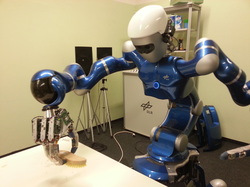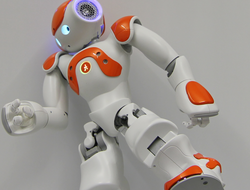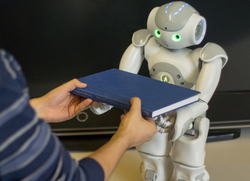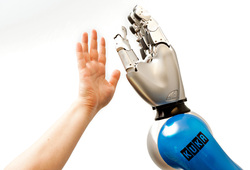
Grasping and Manipulation:
Grasping and manipulation of objects are essential motor skills for robots to interact with their environment and perform meaningful, physical tasks. Robots are still far from being capable of human-level manipulation skills including in-hand or bi-manual manipulation of objects, interactions with non-rigid objects, and multi-object tasks such as stacking and tool-usage. My research focuses on the application of machine learning and imitation learning techniques to allow robots precise and goal-oriented manipulation.
VIDEO
Grasping and manipulation of objects are essential motor skills for robots to interact with their environment and perform meaningful, physical tasks. Robots are still far from being capable of human-level manipulation skills including in-hand or bi-manual manipulation of objects, interactions with non-rigid objects, and multi-object tasks such as stacking and tool-usage. My research focuses on the application of machine learning and imitation learning techniques to allow robots precise and goal-oriented manipulation.
VIDEO

Motor Skill Learning:
Programming complex motor skills for humanoid robots can be a time intensive task, particularly within conventional textual or GUI-driven programming paradigms. Addressing this drawback, we develop machine learning methods for automatic acquisition of robot motor skills. Especially humanoid robots are often intrinsically redundant and can be controlled using a much smaller number of parameters than existing degrees-of-freedom. Using reinforcement learning, in particular policy search, as a basis, we introduced various methods for skill acquisition in humanoid robots. VIDEO
Programming complex motor skills for humanoid robots can be a time intensive task, particularly within conventional textual or GUI-driven programming paradigms. Addressing this drawback, we develop machine learning methods for automatic acquisition of robot motor skills. Especially humanoid robots are often intrinsically redundant and can be controlled using a much smaller number of parameters than existing degrees-of-freedom. Using reinforcement learning, in particular policy search, as a basis, we introduced various methods for skill acquisition in humanoid robots. VIDEO

Physical Human-Robot Interaction:
Close physical interaction between robots and humans is a challenging aspect of robot development. For successful interaction and cooperation, the robot must have the ability to adapt its behavior to the human counterpart. I am investigating the development and evaluation of computationally efficient machine learning algorithms that are well suited for close-contact interaction scenarios.
VIDEO
_
Close physical interaction between robots and humans is a challenging aspect of robot development. For successful interaction and cooperation, the robot must have the ability to adapt its behavior to the human counterpart. I am investigating the development and evaluation of computationally efficient machine learning algorithms that are well suited for close-contact interaction scenarios.
VIDEO
_

Interaction Primitives:
To engage in cooperative activities with human partners, robots have to possess basic interactive abilities and skills. However, programming such interactive skills is a challenging task, as each interaction partner can have different timing or an alternative way of executing movements. We proposed to learn interaction skills by observing how two humans engage in a similar task. To this end, we introduced a new representation called "Interaction Primitives". Interaction primitives build on the framework of dynamic motor primitives (DMPs) by maintaining a distribution over the parameters of the DMP. With this distribution, we can learn the inherent correlations of cooperative activities which allow us to infer the behavior of the partner and to participate in the cooperation
To engage in cooperative activities with human partners, robots have to possess basic interactive abilities and skills. However, programming such interactive skills is a challenging task, as each interaction partner can have different timing or an alternative way of executing movements. We proposed to learn interaction skills by observing how two humans engage in a similar task. To this end, we introduced a new representation called "Interaction Primitives". Interaction primitives build on the framework of dynamic motor primitives (DMPs) by maintaining a distribution over the parameters of the DMP. With this distribution, we can learn the inherent correlations of cooperative activities which allow us to infer the behavior of the partner and to participate in the cooperation
